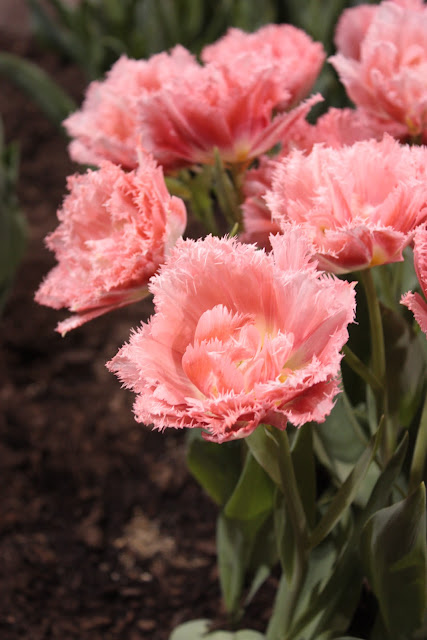 |
| The flowers on an ornamental pear tree |
I usually get a full month's worth of bloom out of these stalwarts in my garden. Not this year. Courtesy of the record-high temperatures, the magnolia has already finished its show in less than a week. My weeping ornamental cherry and ornamental pear are in full bloom while the redbud and crabapple are only a few days behind.
The cherry tree (prunus subhirtella var. pendula) is especially lovely this year. It has been through some exceptionally tough times --- drought the first year followed by cicadas and webworms. It generally hasn't produced a lot of flowers...that is, until this year. The mild winter has resulted in a veritable fountain of flowers that glow in the morning sun.
 |
| The flowers on a weeping ornamental cherry tree |
Ornamental cherries should be in vogue this year, what with the 100th anniversary of Washington, D.C.'s famous trees. They can be a lovely focal point in the right spot. In the Chicago area, that may mean planting them in a location that's sheltered from the worst of the winter winds. They prefer full sun but will take part shade and they like their roots moist, but not wet.
There have been some promising new introductions in recent years Among weeping cherries, there's Pink Snow Showers (prunus subhirtella 'Pisnshzam') and Weeping Extraordinaire (prunus serrulata 'Extrazam'). The latter, which has extra large double pink flowers, was among the plants featured in the "Sweet Melissa" fashion show at the National Green Centre in January.
In addition, there's the Royal Burgundy (prunus serrulata 'Royal Burgundy'), an upright ornamental cherry with reddish purple leaves and deeper pink flowers.
And, of course, you could always plant an Okame cherry, just like those around D.C.'s Tidal Basin. (Yes, they are hardy in Chicago.)
Ornamental pears
Ornamental pear trees (pyrus calleryana) are easy to spot in the landscape this time of year with their white flowers and "teardrop" shape. They often are mistaken for crabapples because the fruits, or "pomes," look a lot alike. The leaves of an ornamental pear are glossy, however, unlike those of a crabapple.
 |
| A callery pear tree in my backyard |
Many homeowners ask for a Bradford callery pear when they go shopping at a nursery. That particular variety, however, is no longer widely grown. Bradford, while beautiful, has been known to split because of the narrow angles where the branches divide from the trunk. Varieties that are now generally available include Aristocrat, Cleveland Select and Chanticleer, all of which are longer-lived and more stable.
Callery pears in general are fast growers and can top out at more than 30 feet when mature. They need full sun and will tolerate many different soils and pollution -- making them a good urban tree.
Redbuds
Eastern redbuds (cercis canadensis) are wonderful small trees with heart-shaped leaves and rosy violet flowers to die for. Their branches have an interesting, almost zig-zag growth habit that provides winter interest.
It's an "understory" tree, topping out at about 15 to 25 feet. Redbuds will take part shade and are stunning in woodland or naturalized gardens. There are several cultivars available besides the straight species including Alba, a white version; Covey, a weeping variety; and Forest Pansy, which has purple leaves. Redbuds sometimes needs a more protected site in the Chicago area as they don't like windy, exposed sites. That's especially true for Forest Pansy.
Combining redbuds with ornamental pears can make a fantastic combination, as seen this past weekend at Millennium Park in downtown Chicago.
 |
| Redbuds and ornamental pears created this Impressionistic tableau Sunday on the Chase Promenade in Chicago's Millennium Park. |
Here's hoping that the cooler temperatures forecast for this coming week will keep these wonderful flowers on the trees longer than was possible with the magnolias. Their color and exuberance are inspiring!
By Karen Geisler

























